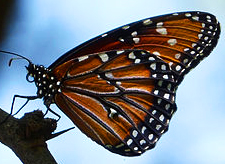For EarthDesk Sunday this week, a lovely iPhone video of hatching Queen Butterflies (Danaus gilippus) shot by Sasha Harris-Cronin while visiting the Butterflies and Blooms exhibit at the Conservatory of Flowers in Golden Gate Park in San Francisco, which runs until March 16, 2014. More on the Queen Butterfy and the exhibit follows.
The Queen Butterfly, According to the Animal Diversity Web at the University of Michigan:

By gailhampshire (Flickr: Queen – Danaus gilippus) [CC-BY-2.0], via Wikimedia Commons
. . . can be found ranging from Brazil to Florida and the Gulf Coast. It is also prevalent in the states of California, Texas, Arizona, and southern New Mexico.
The Queen resembles its close relative the Monarch butterfly (Danaus plexippus) in various ways, but is smaller and the ground color of the wings is a darker brown.
The chrysalis is short, thick, rounded, tapers very quickly over the posterior of the abdomen, and is suspended by a long cremaster from a button of silk. It is frequently ornamented with golden spots.
The site also notes (ironically one hopes):
This species has no known benefits for humans besides being aesthetically pleasing. (Our emphasis added).
From the Butterflies and Blooms exhibit site:
Butterflies & Blooms is a unique opportunity to walk amongst a wide variety of brightly colored daisies, sunflowers, zinnias, and more while free-flying butterflies flit from flower to flower, drinking nectar and getting covered in pollen. These goodwill ambassadors of the insect world provide a fascinating demonstration of plant pollination in action, and the exhibit is designed to highlight the critical role pollinators play in the life cycle of plants.
The Butterfly Bungalow in the middle of the gallery also lets visitors observe one of the most critical stages of the butterfly’s life cycle – the transformation from caterpillar to butterfly. At the Bungalow, visitors see the chrysalises, hardened exoskeletons formed by the caterpillars. These intriguing structures are as varied as the creatures that created them — some jade colored with gold spots, some sporting prominent and unusual horns. Inside, one of the great mysteries of nature is taking place — a total metamorphosis during which the caterpillar liquefies completely and its cells reorganize into a butterfly. Many visitors will be lucky enough to catch the moment when one of these transformed and winged beauties emerges.










